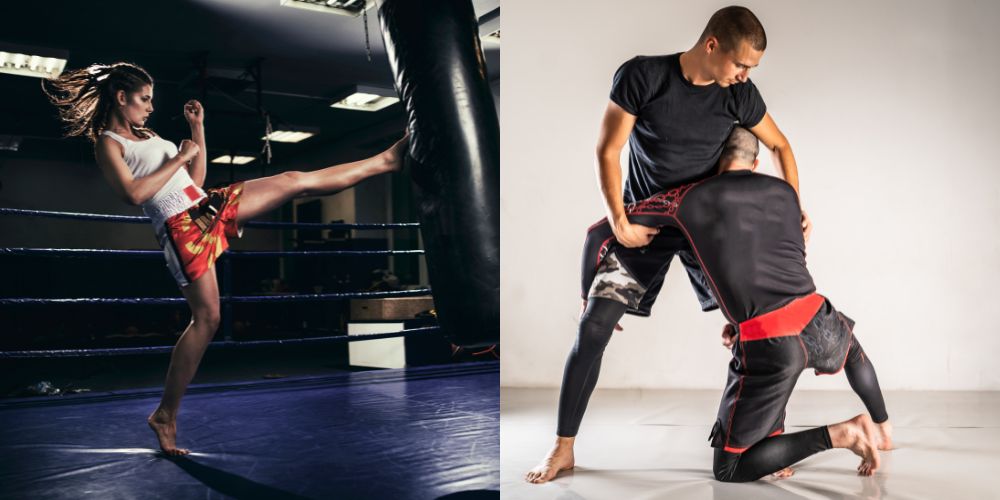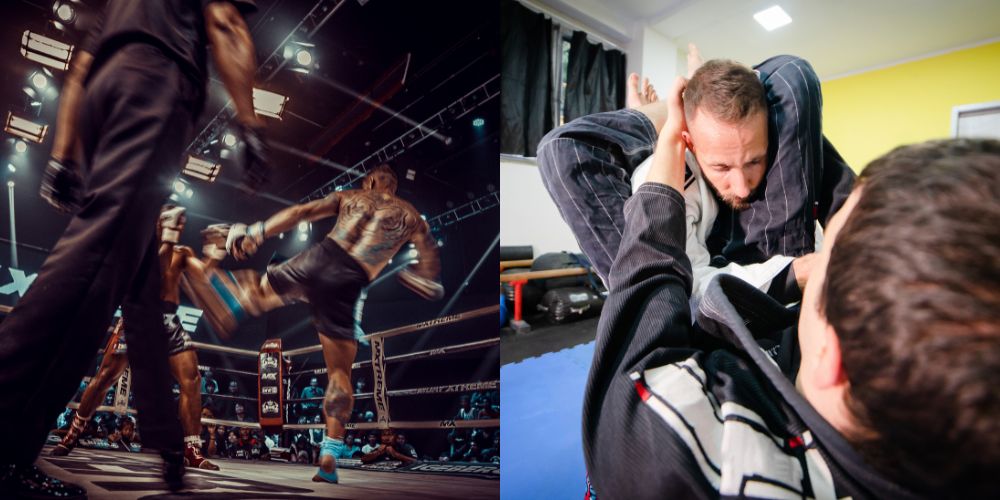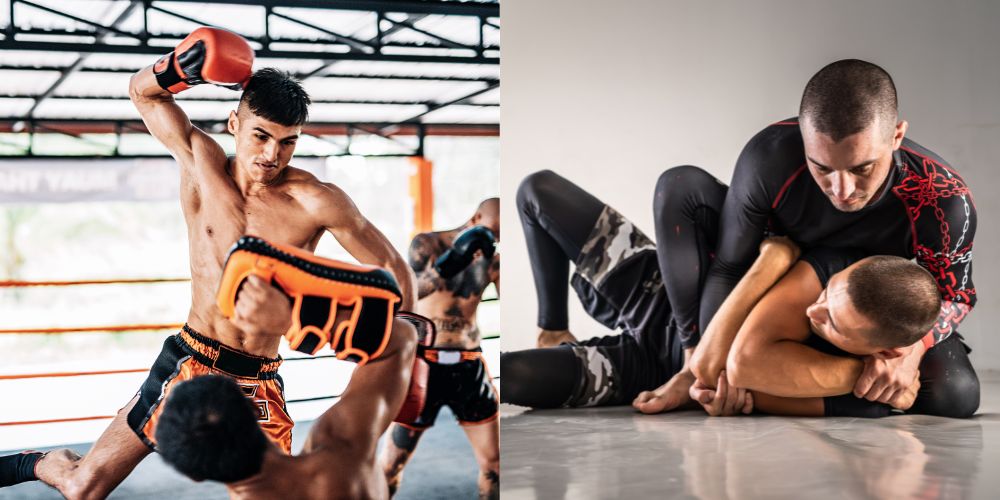Striking and grappling are two sides of the same coin called “fighting.” Usually, martial arts place more emphasis on one or the other, and Muay Thai and Brazilian jiu-jitsu are among the best representations of each. But which is better?
Muay Thai and BJJ each have distinct advantages and are better than the others in different aspects. Muay Thai is a striking martial art and combat sport utilizing all limbs as weapons and is better while the fight remains on the feet, while BJJ is far superior in the grappling department.
Being so different, comparing Muay Thai and BJJ may seem strange. Still, as two of the most popular martial arts on the planet, many people are wondering which one to choose and how they stack up in different situations, and this article has all the answers.
What Is BJJ
Brazilian jiu-jitsu is a comprehensive grappling system from Brazil that teaches how to control and submit an opponent on the ground using leverage and technique.
BJJ emphasizes taking the fight to the ground, where size matters less, and finishing the fight using a joint lock or a choke. It is a well-tested and thoroughly proven effective system for fighting.
BJJ was created in Brazil and is derived from traditional Japanese jiu-jitsu and judo. The style was developed mainly by the Gracie family in the early 20th century. For a long time, BJJ was used for self-defense and no-rules fights, a testament to its effectiveness in actual fighting.
Since the 1990s, BJJ has grown immensely because of its huge success in early MMA, thus proving any complete fighter must also be competent on the ground.
In recent years, BJJ has gained massive popularity as a grappling-only sport and is constantly evolving and becoming more and more elaborate.

How to Dominate Every Fight with Raw, Explosive Power No One Can Match
Discover the underground blueprint that has quietly turned MMA hopefuls into legends, using nothing but sheer, brute force and bulletproof conditioning techniques.
The sports version of BJJ today BJJ has a worldwide competition scene and millions of people practicing for different purposes like fitness, well-being, or as professional athletes.
What Is Muay Thai
Muay Thai is a combat sport and martial art originating in Thailand. It is considered a national treasure and a representation of Thai culture. Muay Thai is a striking combat sport called the “Art of 8 Limbs” because it allows punches, kicks, elbows, and knees.
Muay Thai, which translates as Thai boxing, can be traced back to the 13th century to its historical versions, which have been used extensively on the battlefields.
The art gradually became more systemized and used for sport until it became formalized in the early 20th century after contact with Western boxing.
Added were weight classes, boxing gloves, timed rounds, and the boxing ring, turning Muay Thai primarily into what we know today.
Today, Muay Thai has huge worldwide recognition and follows both as a separate sport and an integral part of MMA.
Using all limbs as weapons and the extensive clinching and close-range fighting has elevated Muay Thai into one of the most effective and realistic combat sports.
Key Differences Between BJJ and Muay Thai

Techniques
Muay Thai operates in the striking domain and uses most body parts as weapons. Nak Muay use punches similar to those in Western boxing, powerful kicks delivered with the shin, elbows, and knees to damage their opponents.
Thai-style kicks are the most powerful roundhouse kicks in all martial arts due to the mechanics aiming to deliver them with the most force possible.
Aside from striking techniques, Muay Thai fighters have a deep knowledge of clinching, which is scored highly in competition.
Landing knees and elbows and throwing or sweeping the opponent from the clinch are integral parts of the game.
BJJ is all about ground fighting and uses many techniques to ensure dominance. Positions like the guard, mount, side control, and back control, among others, are crucial elements of BJJ, while submission holds are used to end the fight.
They range from joint locks that put limbs in painful positions to chokes, which can make you lose consciousness in a matter of seconds. Locking a submission forces the opponent to tap or face the consequences.
Takedowns and throws are also present in BJJ but receive much less attention than in most other grappling martial arts.
Rules
Professional Muay Thai fights are fought in a boxing ring in three or five 3-minute rounds. All punches, kicks, elbows, and knees are allowed, and the fight can be won by a knockout or by a judge’s decision.
Three judges score each round based on several criteria, which include successful striking and effective grappling techniques in the clinch. Scoring in Thailand is slightly different than in most other places, as Thais emphasize certain rounds and certain techniques more than others.
BJJ has two main sports branches: gi and no-gi. As the name suggests, the former uses a traditional gi, which also plays a vital role in grappling as it can be grabbed and used. Grapplers in no-gi BJJ wear rash guards and shorts that cannot be grabbed during the competition.
In both versions, the rules strictly ban all forms of striking. The aim of a match contested on mats is to submit the opponent or win the match on points.
Points are scored for takedowns, guard passes, holding dominant positions like mount, or almost finishing a submission. Different BJJ organizations have different rules, varying depending on competitors’ rank.
Training
Training in Muay Thai is evenly split between solo drills like shadowboxing, bag work, and strength and conditioning and partner/trainer work like pads, clinch drills, and sparring.
On the other hand, BJJ has fewer solo drills and focuses more on training with a partner and live sparring called rolling.
Both sports emphasize constant pressure testing and training with a fully resisting opponent, making them effective in their respective domain.
Equipment
As a striking sport, Muay Thai requires a lot of protective gear, especially for sparring, to ensure optimal safety. This includes:
- Muay Thai boxing gloves
- Muay Thai shin guards
- Headgear
- Elbows pads
- Ankle supports
- Mouth guard
- Groin guard
In terms of clothing, Muay Thai practitioners train in Thai style fight shorts and any t-shirt.
For jiu-jitsu, you need a lot less protective gear, but the clothing requirements are a lot stricter. The traditional version requires wearing a special gi consisting of a heavy cotton top, drawstring pants, and a belt. You must use rash guards, BJJ shorts, and spats for no-gi BJJ.
In terms of protective gear, the only necessary piece is the mouth guard, but you can also use optional headgear and groin guards.
Competitive Landscape
Both sports thrive because of their competitive nature, and the landscape reflects that. Muay Thai is at its finest in its homeland of Thailand, where stadiums and local venues hold events on all levels year-round.
Elsewhere, the scene depends heavily on the country. Some places have well-developed amateur and pro-competition scenes. Others do not. As a whole, Muay Thai has a better competitive landscape in Asia but is well regarded and watched worldwide.
BJJ has done a tremendous job at creating a competitive landscape for all kinds of people, and there is now a huge competitive scene at all levels.
You can start as a fresh white belt and compete against people of your age and skill level. At the other end, there are yearly continental and World championships.
The last few years have also seen a tremendous surge in professional-level grappling, with events like ADCC, WNO, EBI, and UFC Fight Pass Invitational getting more and more attention.
Conditioning
The conditioning demands of striking and grappling are different, as are those of Muay Thai and BJJ. BJJ is all about skill, but strength and endurance become crucial when the skills are equal.
BJJ athletes need to develop all 3 energy systems. Still, they must have serious aerobic endurance because of the 6:1 average work-to-rest ratio, so aerobic conditioning is essential to BJJ conditioning.
Strength training for BJJ is also important as it gives a competitive advantage over similarly skilled opponents. The demands are smaller, but a good BJJ competitor is likely to have good general strength on the basic lifts like bench press, squat, and deadlift.
Grip strength is also crucial in BJJ and must be trained. So a comprehensive strength and conditioning program is a must if you aim to reach higher levels of BJJ.
Muay Thai requires a high level of both aerobic and anaerobic conditioning. Maintaining high output for a whole fight or sparring session is crucial for success, and cardio training is essential.
Traditionally, running is a vital part of Muay Thai, but long, no-rest drills like clinching or shadowboxing mixed with jumping rope are also often used to improve aerobic capacity.
Traditionally, strength training with weights had no place in Muay Thai. Still, in more recent years, Muay Thai strength training has been implemented into the sport with the advancement of sports science and training methods.
The main areas to work on are reactive and explosive strength, improved by exercises like jumps, squats, pull-ups, and many more explosive movements with and without weights.
BJJ vs. Muay Thai For MMA

BJJ and Muay Thai are the two most prominent martial arts in all of MMA, covering the grappling and striking aspects of fighting, respectively.
One thing has become crystal clear: one cannot go without the other in a cage fight, and every MMA fighter needs to be competent on the feet and the ground.
BJJ is the most comprehensive system for submission grappling, and especially in its self-defense version, it is exceptionally effective in MMA. After all, its popularity arose directly from the early success of fighters such as Royce Gracie and other grapplers in MMA.
On the other hand, Muay Thai includes more weapons in a standup arsenal than other combat sports, making it a perfect fit for MMA. The extensive clinching and close-range fighting also help Muay Thai to be the preferred striking discipline of many MMA fighters.
Both BJJ and Muay Thai are crucial for MMA and are considered two of the four main pillars of the sport, so they are equally important and effective.
Of course, like with every other martial art, most techniques and concepts must be modified before they are usable in MMA.
Muay Thai vs. BJJ for Self-Defense

BJJ and Muay Thai are equal in their self-defense applications. BJJ was created as a self-defense system, and the live training with constant sparring preserved that purpose.
BJJ ground fighting skills teach anyone, regardless of size, how to control and subdue an opponent on the ground. The only downside of BJJ for street fights is the lack of striking and in situations with more than one opponent.
Things become more difficult to predict when sports BJJ is brought into the mix. Many of the positions and tactics used in grappling matches are inappropriate for self-defense where striking is present, so this is important to keep in mind.
Muay Thai is also excellent for self-defense. The extensive arsenal of powerful strikes, including punches and kicks from a distance and knees and elbows up close, make Muay Thai effective at all striking ranges, which is very good in unpredictable real-life situations.
Clinching is also very common in street fights, another area in which Muay Thai excels.
Full-contact sparring and training in Muay Thai prepare the body and mind for violence, which is also an important point missing from some martial arts.
Then, the negative side of Muay Thai emerges when the fight hits the ground, where you may be in deep waters without the ability to swim.
BJJ and Muay Thai are excellent for self-defense but in different ways. One can be better than the other, depending on the specific situation.
Who Wins Between BJJ and Muay Thai
Muay Thai and BJJ have unique strengths and weaknesses; depending on the situation, either one can win. From what we know from MMA, if the fight goes to the ground, BJJ will win every time, and if the fight stays standing, the Thai-style fighter will dominate.
Where the fight takes place depends mainly on the personal skills of both fighters. It’s worth noting that Muay Thai fighters are much harder to take down from the clinch, where most BJJ practitioners transition to the ground.
Style vs. style comparisons are usually easier because one has a clear advantage, but in the case of BJJ and Muay Thai, both have high chances of winning, with BJJ enjoying a slight edge.
Should You Start Muay Thai or BJJ?
The best option to become a complete martial artist is to train in both, even if one receives most of your time and effort, but each martial art has immense benefits.
The biggest decision you must make is distinguishing between striking and grappling. Some people have an affinity for one or the other and will always choose based on that.
While with some martial arts, you have to make compromises in effectiveness for self-defense or MMA, in the case of BJJ and Muay Thai, both bring much to the table. The choice again comes down to personal preference, accessibility, and goals.
Both offer well-developed competitive landscapes for amateurs and professionals if you are looking for competition. Both are great for fitness development, each with its intricacies and specifics.
So, the best option is to try both, see what suits you better and where you excel more, and stick with it. Either way, you won’t regret a single second spent training.

